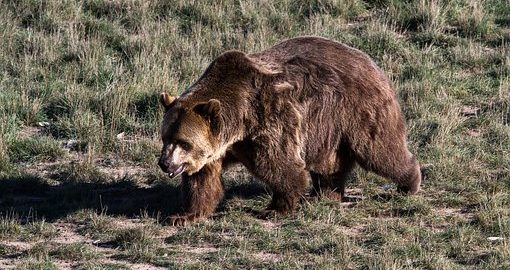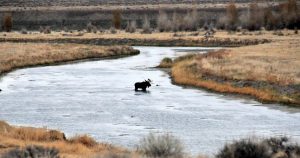 The clocks have moved forward and it is now springtime in Jackson Hole. Grizzly Bear 399 has already been spotted, this time with two cubs in tow. Elk have begun migrating off the Elk Refuge and the moose have left the open plains of the airport, moving north into Grand Teton National Park to grab the fresh new willows along the Snake River and its inlets. We thought this would be the perfect time to remind our visitors of how to continue to protect our wildlife and natural ecosystem.
The clocks have moved forward and it is now springtime in Jackson Hole. Grizzly Bear 399 has already been spotted, this time with two cubs in tow. Elk have begun migrating off the Elk Refuge and the moose have left the open plains of the airport, moving north into Grand Teton National Park to grab the fresh new willows along the Snake River and its inlets. We thought this would be the perfect time to remind our visitors of how to continue to protect our wildlife and natural ecosystem.
Sure, you want to grab the perfect photo shot. Everyone does. But crowding the animals will not guarantee you a perfect photo. It will put you, everyone around you, and the animal in harm’s way. Please be considerate of the animal and everyone else around you.
Grand Teton National Park has some safety precautions on their website that outline exactly what you need to know. In short:
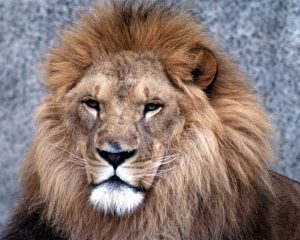
- Keep a distance of 300 feet from bears and wolves and 75 feet from other animals. If they change their behavior, you know you are too close and need to back up slowly.
- The parks are NOT petting zoos. Grand Teton and Yellowstone National Parks are the same as wild animal safaris in Africa, although a lot closer to home.
- Lock your food away at all times, clean up after yourself, and throw away your garbage. A fed bear is an animal they will eventually have to put down because it will come to close to humans for food. Besides, we want to keep this natural paradise pristine for our children.
We have a few other things to keep in mind to keep everyone safe while allowing you to enjoy this wild, natural paradise.
- Wildlife with babies are the most dangerous. If you have ever heard of the saying “She’s a Mama Bear”, you should understand. We suggest giving them even more space and avoid making any large movement or sounds. Under no circumstances, should you get in between the mom and baby.
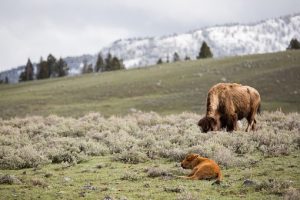
- As a natural ecosystem, there is an ebb and flow. For all animals to exist in balance, occasionally some have to die. As humans, we have natural inclinations to save a struggling baby animal and want to rescue it. Unfortunately, when we interfere in the natural world, we seal their fate and they have to be put down as the herd will not accept them back. If you struggle with this (as most would), keep driving and remind yourself that this is the “wild, natural world finding its balance.”
- If you see some wildlife and want to take some photos, pull over onto the shoulder of the road. Stay in your car and use a zoom camera to get those close up shots.
- Have a conversation, use a bell, or otherwise make noise on a hiking trail to alert animals that you are coming. If they haven’t already smelled you, they will appreciate the notification that you are on your way.
- Lastly, if you find yourself too close to an animal on a hike and they charge you, do not run. Get into the fetal position and protect your head and neck.
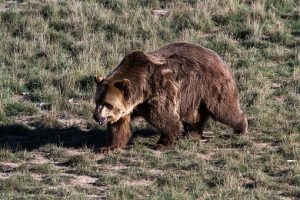 To give you a little further incentive to keep your distance from the animals, we wanted to give you an idea of how fast our animals can run. Bear run at 30 mph (48kph), moose run at 35mph (56kph), bison or American Buffalo run at 40mph (64kph), and elk run at 45mph (75kph). Additionally, moose can swim at 6mph (9kph). By comparison, an average healthy adult human runs somewhere between 10-15 miles per hour. If you stay in the safety of your car, you do not have to worry about how easily any one of these animals will catch up to you.
To give you a little further incentive to keep your distance from the animals, we wanted to give you an idea of how fast our animals can run. Bear run at 30 mph (48kph), moose run at 35mph (56kph), bison or American Buffalo run at 40mph (64kph), and elk run at 45mph (75kph). Additionally, moose can swim at 6mph (9kph). By comparison, an average healthy adult human runs somewhere between 10-15 miles per hour. If you stay in the safety of your car, you do not have to worry about how easily any one of these animals will catch up to you.
We may sound overly cautious but our goal is to keep you safe! We do not like hearing about our visitors or our wildlife getting hurt. Viewing wildlife in the distance is the best place to see them for all involved.
But how? And where? Oh yes! So our wildlife likes to avoid humans. In order to see wildlife, you have to be where other humans are not. Thus, you must:
- Search in the early morning (before 8 am) and very late evening (after 7 pm).
- Look near watering holes.
- Drive extra slow (they are stealthy and blend in).
- Be quiet (but only if you are in your car).
- Follow scarcely traveled public dirt roads.
- Hike on the higher elevation trails.
- Drive farther back in the Gros Ventres, Hobacks, or the Wyoming Range.
- Camp overnight away from populated campgrounds.
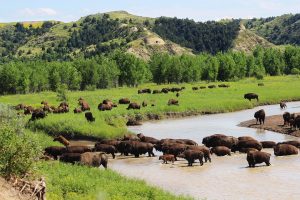
- Search in areas of their favorite food groups…bears like huckleberries, moose love willows, elk, deer, pronghorn, & bison feed on grasses, coyotes and fox enjoy small mammals, and wolves and mountain lions prey on bigger mammals.
And if you really want to see wildlife, come visit Jackson Hole in April or in October. They are everywhere you look! Just be forewarned, the weather is a little variable this time of year…and don’t forget to prepare for your travels!

